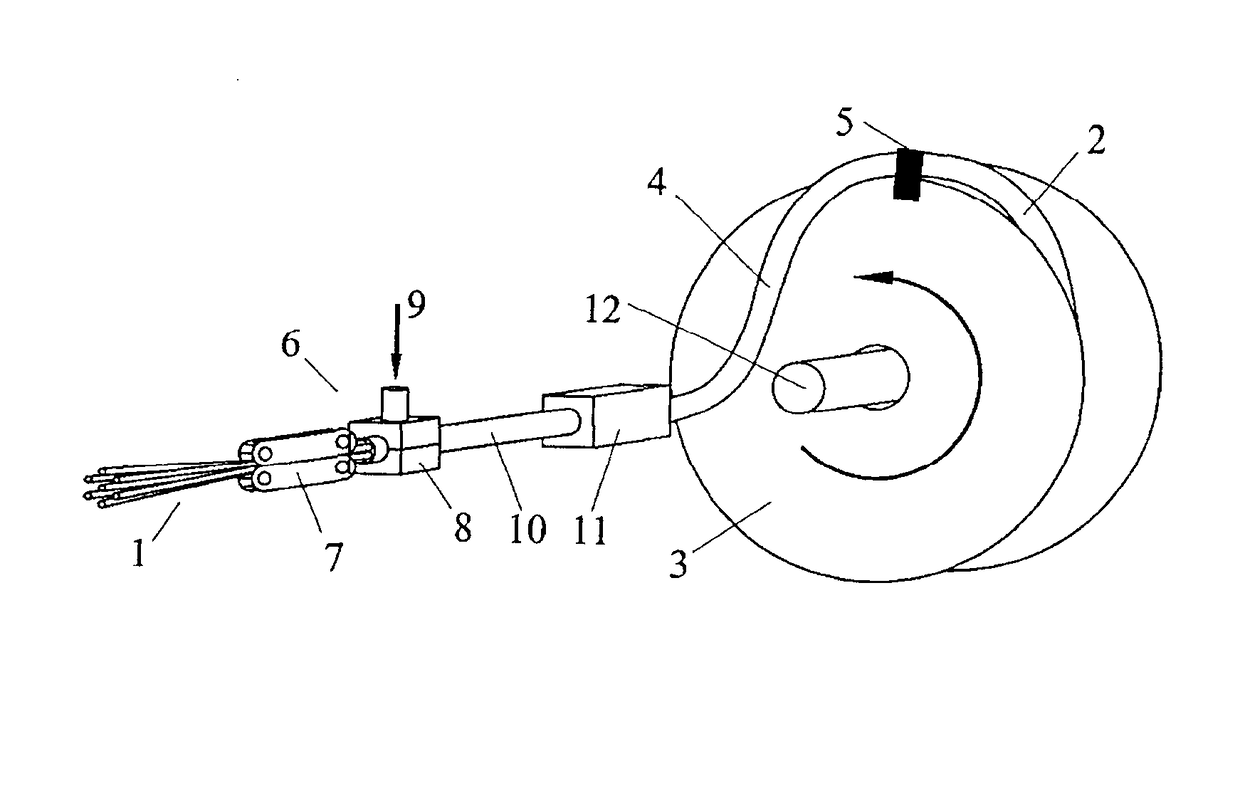Method and device for installing cable into cable guide tubing
a cable guide and cable technology, applied in special-purpose vessels, instruments, manufacturing tools, etc., can solve the problems of difficult connection, difficult completion of the connection, and difficulty in completing the connection, and achieve the effect of facilitating the introduction of cable into the duct and cost-effectiveness
- Summary
- Abstract
- Description
- Claims
- Application Information
AI Technical Summary
Benefits of technology
Problems solved by technology
Method used
Image
Examples
example 1
Comparative
[0038]Seven microducts each having an external diameter of 7 millimeters (i.e., describing a “cable” as discussed herein) were simultaneously introduced into a duct having an internal diameter of 23 millimeters via a blowing method using equipment as disclosed in European Patent No. EP 0,292,037 (and its counterpart U.S. Pat. No. 4,934,662). The length of the duct was 500 meters. The cable (i.e., the seven microducts) did not reach the end of the duct; the cable was blown into the duct over a distance of only 16 meters.
example 2
Comparative
[0039]A cable consisting of four microducts each having an external diameter of 12 millimeters was introduced into a duct having an internal diameter of 33 millimeters via a blowing method. The length to be installed was 950 meters using equipment as disclosed in European Patent No. EP 0,292,037 (and its counterpart U.S. Pat. No. 4,934,662). The installation length that could be achieved was acceptable, but the operation was frequently found to be difficult. The required compressed air pressure was too high, introducing considerable risk of microduct implosion. In general, using high pushing pressure such as that required here can cause microduct damage.
example 3
Comparative
[0040]Using the method described in Examples 1 and 2, four sub-bundles of (i) six microducts each having an external diameter of 4 millimeters and (ii) being wound around a central stiffening element having a diameter of 4.2 millimeters were introduced into a duct having an internal diameter of 33 millimeters. A length of 950 millimeters was achieved, but the same problems described in Example 2 were encountered. Moreover, the field installation resulted in different lengths of the six sub-bundles within the duct. As noted, this leads to protrusion problems (e.g., buckling of the microduct sub-bundles) when the duct is opened to facilitate connection operations.
PUM
| Property | Measurement | Unit |
|---|---|---|
| oscillation angle | aaaaa | aaaaa |
| internal diameter | aaaaa | aaaaa |
| internal diameter | aaaaa | aaaaa |
Abstract
Description
Claims
Application Information
 Login to View More
Login to View More - R&D
- Intellectual Property
- Life Sciences
- Materials
- Tech Scout
- Unparalleled Data Quality
- Higher Quality Content
- 60% Fewer Hallucinations
Browse by: Latest US Patents, China's latest patents, Technical Efficacy Thesaurus, Application Domain, Technology Topic, Popular Technical Reports.
© 2025 PatSnap. All rights reserved.Legal|Privacy policy|Modern Slavery Act Transparency Statement|Sitemap|About US| Contact US: help@patsnap.com

